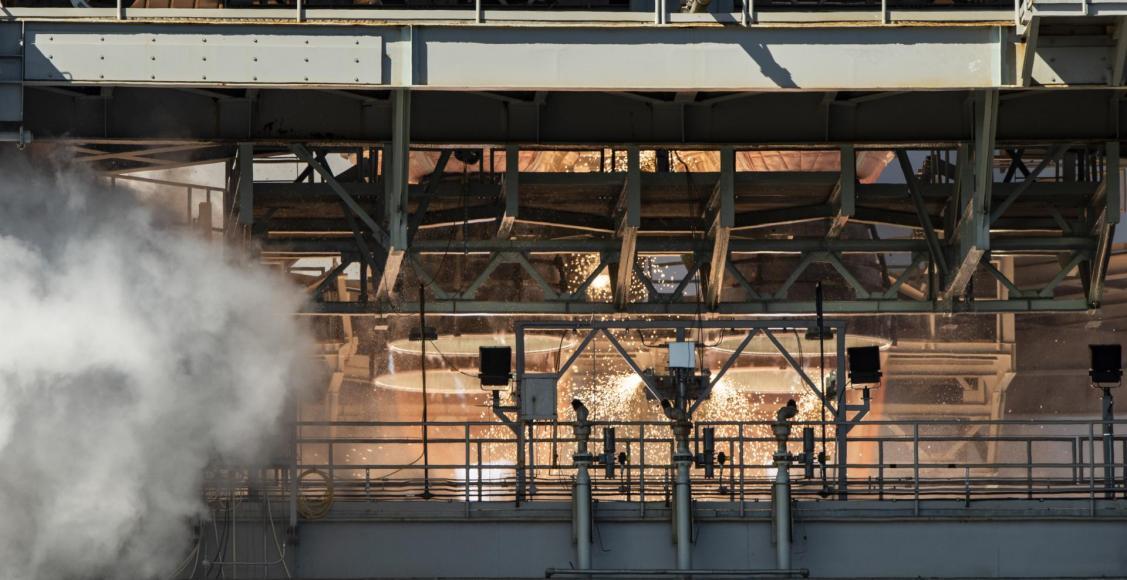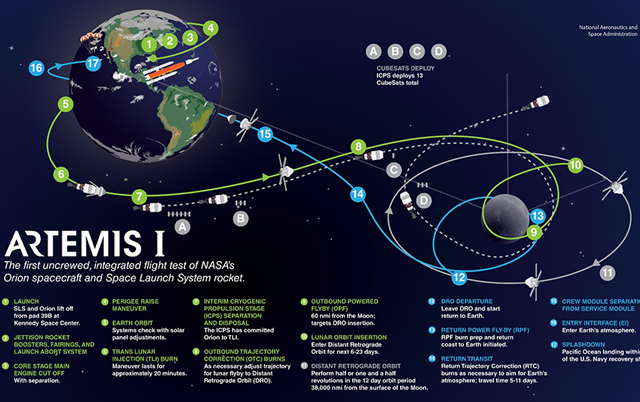Artemis
NASA's Artemis program will land the first woman and first person of color on the Moon to explore the lunar surface like never before. This bold endeavor officially began Nov. 16, 2022 with the Artemis I launch - an uncrewed flight test.
Artemis I, the first integrated test of NASA's Space Launch System (SLS) and Orion spacecraft, successfully ended on Dec. 11, 2022. SLS and Orion blasted off from Launch Complex 39B at Kennedy Space Center in Florida to send Orion into a lunar distant retrograde orbit – a wide orbit around the Moon that was farther from Earth than any human-rated spacecraft has ever traveled. The uncrewed mission validated the design and safety of SLS and Orion for human exploration missions to follow. Aerojet Rocketdyne provided 39 propulsive elements for the Artemis I mission (38 liquid engines and 1 solid rocket motor), as well as 14 high pressure tanks.
SLS is the nation's next-generation heavy-lift rocket that will carry humans farther and faster into deep space than ever before. Aerojet Rocketdyne provides the four powerful RS-25 main engines used to help propel SLS with over 2 million pounds of combined thrust, as well as the RL10 engine that propels the vehicle's Interim Cryogenic Propulsion Stage (ICPS), or second stage. The RL10 provides the power to accelerate Orion to speeds of more than 20,000 miles per hour and set it on a course for the Moon. The ICPS also features 12 MR-106 Reaction Control System thrusters providing pitch, yaw and roll control for the upper stage, as well as settling burns.
Aerojet Rocketdyne's role on Orion includes the 6,000 pound-thrust main engine on the spacecraft's service module; eight auxiliary engines used to maintain Orion's in-space trajectory and position; the jettison motor that separates the Launch Abort System from the spacecraft; 12 Reaction Control System thrusters that control the spacecraft's reentry into Earth's atmosphere; one nitrogen tank on Orion service module for cabin pressurization; and five composite overwrapped pressure vessels that store high-pressure helium to inflate Orion's flotation system upon water landing.
Videos
Aerojet Rocketdyne Artemis B-Roll
What is Artemis?
What is the RS-25 Rocket Engine?
RS-25 Engine Testing
Testing Orion's Jettison Motor
SLS Fuel for Thought
Without Limits
We Dare to Dream
What is EUS?
News Updates
- Aerojet Rocketdyne to Provide Propulsion for Three Additional Orion Spacecraft
- Aerojet Rocketdyne Delivers Propulsion for Artemis III Mission
- Aerojet Rocketdyne Propulsion Soars in Successful SLS Debut
- RS-25 Engines on Artemis I Will Pass the Torch from One Era to Another
- Mission Critical AEPS Thruster Completes Development Testing for NASA’s Lunar Gateway
- From the Test Stand to the Launch Pad: NASA’s First Space Launch System Core Stage Delivered to Kennedy Space Center
- Aerojet Rocketdyne RL10 Engines Set Stage for SLS Evolution
- Gearing Up for SLS Green Run’s Main Event
- Aerojet Rocketdyne Completes Successful Space Launch System Rocket Engine Test Series
- Aerojet Rocketdyne Awarded NASA Contract for Orion Spacecraft Main Engine
- Aerojet Rocketdyne Expands Los Angeles Facility for NASA’s Moon and Mars Rocket
- Successful SLS Core Stage Hot-Fire Test Puts America One Step Closer to Returning to the Moon
- Upcoming RS-25 Engine Test Series Will Demonstrate Lower Cost Rocket Engine Components for NASA’s Artemis Program
- NASA’s Artemis I Progresses Toward Launch
- Gearing Up for SLS Green Run's Main Event
- RS-25 Engines Successfully Integrated with Space Launch System
- Jettison Motor Proves Launch Abort Capability for Orion Spacecraft
- Motor Demonstration Marks Successful Transition of Aerojet Rocketdyne’s Jettison Motor Program to Orange, Virginia
- SLS Core Stage Receives Four RS-25 Engines for First Flight
- All RS-25 Flight Controllers Delivered for First Four Flights of NASA’s SLS Rocket
Resource Links
- Aerojet Rocketdyne’s SLS Webpage and Photos
- Aerojet Rocketdyne’s Orion Webpage and Photos
- Aerojet Rocketdyne’s RS-25 Webpage and Photos
- Aerojet Rocketdyne’s RL10 Webpage and Photos
- RS-25 Incredible Facts
- RS-25 Data Sheet
- SLS Capabilities Booklet
- NASA RS-25 Infographic
- NASA "I Am Artemis" Profile: Aerojet Rocketdyne's Jerit Wendlandt
- NASA "I Am Artemis" Profile: Aerojet Rocketdyne's Rachel Hsiong
- Aerojet Rocketdyne Artemis Coloring Sheet







